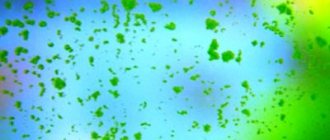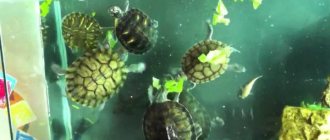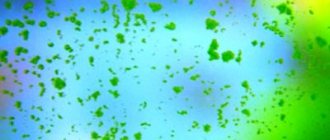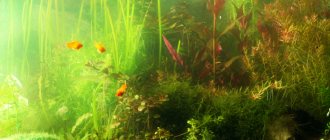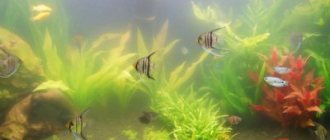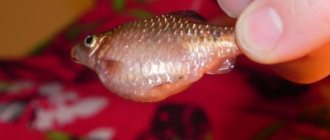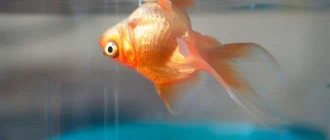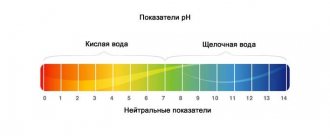4.8
(84)
Fish, like all living creatures, suffer from various diseases. In an aquarium it is easier to recognize the disease and begin timely treatment.
Types of diseases
Diseases of aquarium fish are divided into 3 types:
- contagious;
- invasive;
- non-infectious.
Now in more detail about each type.
Symptoms
Lethargy, with no other signs of illness usually present. When examining the gills under a microscope, tiny bubbles can be found on the gill fibers. If gas bubbles form on glass and other surfaces in the aquarium, and the fish look unhealthy, then this disease should be suspected. In acute cases, bubbles may also appear on the fish themselves, sticking to the outer surface of the body. Death may occur as a result of the disease, and if exposure is not severe enough to cause death, it may cause brain damage. In spawning and nursery aquariums, affected eggs and fry may become buoyant, and the yolk sacs of the fry will visibly swell as they are filled with gas.
The formation of gas bubbles (usually nitrogen) occurs due to the oversaturation of the aquarium water with it. This phenomenon is similar to decompression sickness in divers.
Various cases that can happen to an aquarium
Air bubbles rising from the bottom.
The rise of air bubbles from the bottom of the aquarium at one time worried me extremely and even seemed to be the reason for the death of some of my fish. Subsequently, however, I became convinced that this was either simply air remaining in the ground while covering it with sand, which, having accumulated in some places, little by little tries to escape, or even if it was swamp gas - methane formed from rotting roots or generally any other underground parts of the plant, then, in any case, the gas is not at all harmful to the life of fish. In general, this phenomenon mostly happens only when the plants are not planted in pots, but directly in the ground, and when this soil consists of earth or silt covered with sand on top. When planting plants in pots, bubbles are much less likely to occur. The reason, however, is the same.
The appearance of foam on the surface of the aquarium.
The appearance of foam on the surface of the water usually indicates a lack of oxygen in the water, especially if this foam is accompanied by the smacking of fish. Sometimes, however, it also appears when the fish have eaten too much and, feeling the need for an increased influx of oxygen, rise to the surface and inhale atmospheric air, and when exhaling, they release bubbles to the surface. In both cases, the best remedy is to add a carafe or two of cold water or pump air into the water using the devices described above.
The appearance of flour-like clouds on the surface of the aquarium.
I call them floury because when you touch them, they actually crumble like flour or sand. It is best to see them if you take a little from the surface in a glass of water. Then if you touch the surface, when everything calms down, then crumbly milky white clouds will go down. These clouds consist of countless bacteria and come from the rotting and decomposition in water of some animal organism or food not digested by fish. As soon as they appear, you need to immediately change all the water, wash the entire aquarium and do this until they completely disappear, otherwise a small amount is enough to cause all the water to rot again. Another remedy is to add a little salt or, better yet, salt water to remove plaque from the surface. These clouds indicate the complete decomposition of water and their phase is especially dangerous, when they turn from flour-like clouds into a white, viscous, patchy coating.
Blue coating on the water.
This coating has nothing in common with the previous one, although it is somewhat similar in patchiness and covers most of the surface of aquariums in apartments where the rooms are low and where, therefore, the air is replete with dust and carbon dioxide. This coating is completely safe and often appears almost immediately after pouring fresh water. You can easily reduce it by carefully immersing the glass in water, so that the films on the surface along with the water flow into it. The quieter and more carefully you lower the glass, the more plaque gets into it, which will flow into it in the form of white shreds. By immersing the glass several times in this way, you can collect all the plaque in 5-10 minutes. Instead of a glass, you can also immerse a bottle in water, and then the light will rush into it with a stream of water through the neck. The whole art is in patience, and the one who can immerse a glass or bottle so that they barely touch the surface covered with plaque and the water flows into them, carrying with it as much plaque as possible, will be able to collect it very quickly. Of course, you need to immerse a glass or bottle not in one place in the aquarium, but in different ones, mainly where more plaque has accumulated. This coating appears mainly in perch fish, labyrinth fish - generally quiet-swimming fish, and almost never in goldfish, since they, every now and then, swimming near the surface, eat it all up.
Whitish coating on plants.
Sometimes a light fluffy coating appears on the branches and even on the surface of the leaves (especially Elodea) of underwater plants, somewhat similar to that velvety mold that covers bread, cheese, etc. substances. This bloom is the most interesting of the ciliates - lily of the valley. As soon as you notice it, immediately remove it carefully and place it under the microscope, and your eyes will be presented with the most delightful of pictures. The movement of the cilia of the beetles, the contraction and stretching of their legs, the grasping and swallowing of prey - all these are such curious things that there is no way to describe them, you must definitely see them yourself.
Brown coating on glass.
The cause of such plaque is either diatoms (they can be clearly distinguished under a microscope), or, what happens less frequently, various iron compounds, which, under the influence of heat, decompose and are deposited on the glass in the form of a thin brown film. Sometimes the reason for this is the fungi Leptothrix ochracea and algae Crenothrix polyspora contained in water taken from some source, due to which the water in such sources is reddish. It can be removed only with a rag with chalk or pumice. To remove plaque that comes from dead green algae, it is enough to resort to a rag.
The appearance of small worms at the bottom.
Small, thin, like threads, worms, sometimes swaying in whole heaps at the bottom of the aquarium - there is a genus of worms Tubifex (Saenuris) rivulorum, which I have already written about in detail above. Their appearance depends on the presence of silt in the ground of the aquarium - their favorite habitat. Swinging in all directions, as if under the influence of some kind of current, these worms serve as excellent, although not particularly dense food for fish and, as many people think, do not cause any harm to anyone.
Harmful fungus.
The interesting sulfur fungus described in Part II on page 240 can, unfortunately, be very dangerous for fish and fish fry. By releasing sulfuric acid, it contaminates the water and causes suffocation. Its appearance depends on careless feeding of daphnia and cyclops, which, being given in such abundance that the fish are not able to eat them all, often die, and their corpses, decomposing, contribute to its development. Fortunately, getting rid of it is not particularly difficult: just change the water in the aquarium several times in a row, and it will immediately disappear.
Aquarium glass cracking.
Cracked glass in an aquarium is one of the most amazing episodes in the life of an aquarium lover. Has the glass broken? Why, why? How to help the grief? - he asks himself questions in fright, and while he is asking them and does not know what to do, water rushes out and floods the room. Since this cracking occurs for the most part completely unexpectedly and often, apparently, even without any reason, I will try to tell first the precautions that should be taken to prevent this extremely unpleasant event, and then the measures that need to be taken in case , if this trouble, despite all the precautions taken, had already happened. I said that the cracking appears to occur without any reason, but in fact there is almost always a reason. The main one is the incorrect setting of the aquarium. In ordinary times, tilting the aquarium in one direction or another does not mean anything, but in hot weather, when the glass greatly expands under the influence of heat and, therefore, becomes thinner, the slightest stronger pressure on any point of the glass leads to cracking. That is why, when installing an aquarium, you need to pay special attention to ensure that it does not tilt in any direction. It is most convenient to perform this leveling when there is still very little water in the aquarium. Then, by placing pieces of paper folded tenfold or more under one or the other leg of the table on which it stands, it is easy to ensure that the aquarium stands completely straight and the water presses on all sides with equal force.
Another reason is careless glass insertion. The glass of the aquarium is smeared with two types of putty: red lead and brown cement. Red lead, softening from the heat, does not present any special tricks when smearing glass, but is not durable, and cement, on the contrary, must be handled skillfully, since, hardening from the heat, it represents a huge obstacle to the expansion of glass at this time and, preventing there is room for it to expand, causing it to bend and burst. Knowing this property, experienced craftsmen never cover it closely with cement putty, but always leave some free space for the glass to stretch and thereby prevent it from cracking, while painters, on the contrary, do not pay attention to this, and therefore the glass inserted by this kind of workers is things are falling apart. That’s why it’s better to overpay twenty to fifty kopecks and have the glass smeared by a good craftsman, a specialist, rather than skimping and then crying.
The last reason, finally, is the incorrect curvature of the glass. With mirror glass this phenomenon is, of course, quite rare, but with double and triple glass it happens all the time. It can only be prevented by careful observation when choosing glasses. If the evil has already been done, then the only way to reduce the chances of glass cracking is to slightly deflect the water pressure in the opposite direction. We have already said how to do this when describing the first reason.
So, here are the steps you can take to prevent glass from cracking. Let us now point out the means that should be resorted to when the glass has already burst.
Glass cracking occurs in two ways: either gradually or immediately. If gradually (sometimes it happens that, for no apparent reason, cracks appear in the middle of the glass, mostly mirror glass), then you must immediately seal the crack with sealing wax or parchment paper with syntheticon, and especially carefully the place where the crack ends. This method can sometimes not only delay, but even completely stop the cracking of glass. If, however, water begins to flow immediately, then first of all, release the water with a siphon and release it until the water pressure decreases so much that the cracked parts of the glass come together and the flow stops. Then, if the crack is not very significant, you can try to seal it with sealing wax. Sealing with sealing wax this time presents much more difficulties than in the first case, since before sealing, you need to carefully connect the parts of the glass, wipe them dry from the outside, and then sculpt them only with burning sealing wax, i.e., so that those glued to parts of the sealing wax were burning on the glass. The same precautions must be taken when sealing with parchment containing syndeticon. Having sealed it in this way, you can try to fill the aquarium with water, and it often happens that such putty lasts for two or three or even more weeks, but other times it does not last even a minute. In the latter case, having poured out the water again until the flow stops, there is only one thing left to do - catch the fish, take out the plants and take the aquarium for repairs, but again take it not to the painter, but to a good store, otherwise there will be no end to the repairs and it will be cheap will come at a cost.
Why do fry sometimes die?
As is known, fry often die en masse at their youngest age. According to the observations of V.S. Melnikov, who devoted a lot of time to this issue, one of the main reasons for such, often incomprehensible, death is the spoilage of water, which occurs from the rotting of the milt released by the male during fertilization of the eggs. As the best way to get rid of this death, he recommends a simple remedy that he has tested more than once - transferring the fry at the age of 5-6 days to another aquarium with clean water and exactly the same temperature as where they were previously sitting. Transfer must be done using a white porcelain saucer. In addition, water renewal can also be done by slowly pumping out water and gradually replacing it with new water.
Why do fry of the same age come in different sizes?
According to the observation of some amateurs, the difference in the growth of fry depends on the degree of fertilization of the eggs. Well-fertilized eggs produce large, healthy fry, poorly fertilized eggs produce weak, small ones, and unfertilized eggs become covered with fungus and die.
The easiest to grow aquatic plants.
The easiest to grow aquatic plants are all the pinnates (Myriophyllum), Heteranthera zosterifolia, water moss (Fontinalis antipyretica), Sagittaria natans and S. sinensis, which grow directly in the river sand, as well as all the hornworts (Cerathophyllum), duckweed and marshweed (Chara fragilis ), which do not require any soil, but float directly in the water.
Which fish do not require saturation of water with air?
The most unpretentious in terms of air and water purity are all labyrinth fish, all viviparous fish, loaches and most catfish. They can live in the smallest aquariums and without any water purging.
Cinnabar-red mass on beetles.
This mass is something other than parasitic larvae of Nesaea coccinea Koch mites. They can be found especially often on the belly and bases of the legs of water lovers.
Cause
Oversaturation of water with gas (mainly nitrogen). This occurs when cold water, rich in gas, heats up quickly. As the temperature rises, its ability to transport gases decreases, causing the water to become oversaturated with gas and form bubbles. The same phenomenon can be observed in pots with cold water during the heating process. Overgassing occurs when fresh tap (and therefore gaseous) water is filled into a newly installed aquarium and quickly reaches operating temperature. The same thing happens if, when replacing a significant part of the water, cold or quickly heated water is added to the aquarium. Fish in such conditions inhale gas in excess concentrations. This gas then leaves solution into the blood and causes a gas embolism (blockage of blood vessels by gas bubbles). Using powerful electric centrifugal pumps in aquariums that are too small can also cause the water to become oversaturated with gas - this is possible, although unlikely. Judicious use of suitable equipment will avoid the risk of this disease.
Types of aquarium fish diseases
Diseases in aquarium fish are divided into non-contagious and contagious. The former develop under the influence of unfavorable external factors (low-quality feed, temperature disturbances, etc.). The latter arise under the influence of pathogens that quickly spread in the confined space of an aquarium and can destroy all its inhabitants.
In turn, contagious diseases are invasive and infectious. The former develop due to infection by parasites. The causative agents of the latter are viruses, fungi and bacteria.
Note
Measuring the nitrogen content of water requires specialized (and quite expensive) equipment, but a simple finger test can be used to determine whether the water is oversaturated with gas. This test is as follows: if numerous bubbles form on a dry finger immersed in the aquarium for about one minute, then there is a problem of oversaturation in the aquarium. This test can also be used to test newly filled tap water before adding it to the aquarium.
How to fix the problem
Once it has been determined what causes the foam, immediate action must be taken. The most common ways to solve the problem include:
- inspect the scenery and remove all objects that stain the water. The appearance of foam formations occurs as a result of the lack of pre-treatment of objects. Driftwood and other decorations must be washed with running water and treated with an antiseptic;
- check the condition of the filters. Remove dirt and rinse all tubes with water;
- Before using any chemical, it is necessary to test it in a small amount of water. If such a substance has already been used, it is necessary to partially refresh the water;
- resettle the fish. For small aquatic inhabitants, you must adhere to the rule for 5 liters of 1 small fish. For large fish, at least 10 liters per individual is required;
- installation of an additional aeration system. You can purchase such a device at any specialized store;
- soil that is contaminated must be removed from the container and treated with boiling water. This will eliminate all harmful microorganisms and chemical residues. The nutrient layer must be used new;
- Water renewal should be carried out no more than once a week;
- If foam formations appear, it is necessary to reduce the amount of feed used and clean the container. Often leftover food and dead fish accumulate among the decorations.
Aquarists also recommend using high-quality filters to purify water. Select a device depending on the volume of liquid, otherwise the filter will not be able to cope with the tasks.

